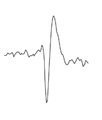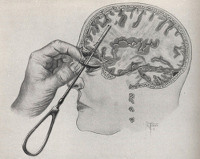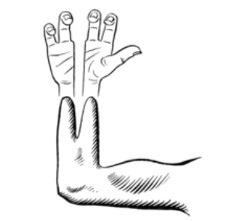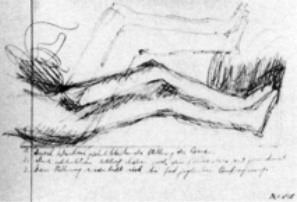Tom Stafford's Blog, page 40
January 18, 2014
2014-01-17 Spike activity
Quick links from the past week in mind and brain news:

Wired magazine has an excellent profile of artificial intelligence bossman Geoff Hinton.
Is it time we stopped ‘sectioning‘ people? Thought-provoking piece on the excellent Psychiatry SHO blog.
The New York Times has an insightful piece on what the ‘marshmallow study’ really tells us about self-control.
Tough love for fMRI. Interesting piece on fixing the problems with fMRI research on the Neurochambers blog.
Nature discusses why ‘irrational’ choices can be rational. Are you reading moustache haters?
Caffeine’s little memory jolt garners a lot of excitement. A fascinating discussion on caffeine and memory boosts from Scicurious newly located blog.
Science News reports on how the brain weighs more when you think harder due to increase blood flow.
An artist made a life-sized skull made of compressed cocaine and it got posted to BoingBoing. Can’t wait for the Viagra sculpture.
Live Science reports on a new study finding that people can register an image in 13 milliseconds.
Cannabis and memory loss: dude, where’s my CBD? Interesting The Guardian piece argues that legalisation may have a knock on effect of making cannabis with higher levels of beneficial CBD more widely available.


January 17, 2014
What’s the evidence on using rational argument to change people’s minds?
Contributoria is an experiment in community funded, collaborative journalism. What that means is that you can propose an article you’d like to write, and back proposals by others that you’d like to see written. There’s an article I’d like to write: What’s the evidence on using rational argument to change people’s minds?. Here’s something from the proposal:
Is it true that “you can’t tell anybody anything”? From pub arguments to ideology-driven party political disputes it can sometimes seem like people have their minds all made up, that there’s no point trying to persuade anybody of anything. Popular psychology books reinforce the idea that we’re emotional, irrational creatures (Dan Ariely “Predictably irrational”, David McRaney “You Are Not So Smart”). This piece will be 2000 words on the evidence from psychological science about persuasion by rational argument.
If the proposal is backed it will give me a chance to look at the evidence on things like the , on whether political extremism is supported by an illusion of explanatory depth (and how that can be corrected), and on how we treat all those social psychology priming experiments which suggest that our opinions on things can be pushed about by irrelevant factors such as the weight of a clipboard we’re holding.
All you need to do to back proposals, currently, is sign up for the site. You can see all current proposals here. Written articles are Creative Commons licensed.
Back the proposal: What’s the evidence on using rational argument to change people’s minds?
Full disclosure: I’ll be paid by Contributoria if the proposal is backed
Update: Backed! That was quick! Much thanks mindhacks.com readers! I’d better get reading and writing now…


January 16, 2014
Parental advisory: teenage kicks in progress
 New York Magazine has an excellent piece on whether adolescence is really a time of turmoil for young people or whether it is actually the parents that find their kids’ teenage years the most challenging.
New York Magazine has an excellent piece on whether adolescence is really a time of turmoil for young people or whether it is actually the parents that find their kids’ teenage years the most challenging.
The article is a brilliant alternative take on adolescence and looks into a range of studies on how teens develop and how it affects the changing parent-teen relationship.
Laurence Steinberg, a psychologist at Temple University and one of the country’s foremost authorities on puberty, thinks there’s a strong case to be made for this idea. “It doesn’t seem to me like adolescence is a difficult time for the kids,” he says. “Most adolescents seem to be going through life in a very pleasant haze.” Which isn’t to say that most adolescents don’t suffer occasionally, or that some don’t struggle terribly. They do. But they also go through other intense experiences: crushes, flirtations with risk, experiments with personal identity. It’s the parents who are left to absorb these changes and to adjust as their children pull away from them. “It’s when I talk to the parents that I notice something,” says Steinberg. “If you look at the narrative, it’s ‘My teenager who’s driving me crazy.’ ”
In the 2014 edition of his best-known textbook, Adolescence, Steinberg debunks the myth of the querulous teen with even more vigor. “The hormonal changes of puberty,” he writes, “have only a modest direct effect on adolescent behavior; rebellion during adolescence is atypical, not normal.”
A fascinating and very well-written piece.
Link to NYMag article ‘The Collateral Damage of a Teenager’


January 13, 2014
Ghost psychiatry
 The Australian Journal of Parapsychology has an article about post-traumatic stress disorder in people who have been murdered.
The Australian Journal of Parapsychology has an article about post-traumatic stress disorder in people who have been murdered.
I suspect diagnosing mental disorder in those who have passed onto another plane of existence isn’t the easiest form of mental health assessment but it seems this gentleman is determined to give it a go.
Psychological phenomena in dead people: Post- traumatic stress disorder in murdered people and its consequences to public health
Australian Journal of Parapsychology, Volume 13 Issue 1 (Jun 2013)
Wasney de Almeida Ferreira
The aims of this paper are to narrate and analyze some psychological phenomena that I have perceived in dead people, including evidence of post-traumatic stress disorder (PTSD) in murdered people. The methodology adopted was “projection of consciousness” (i.e., a non-ordinary state of consciousness), which allowed me to observe, interact, and interview dead people directly as a social psychologist. This investigation was based on Cartesian skepticism, which allowed me a more critical analysis of my experiences during projection of consciousness. There is strong evidence that a dead person: (i) continues living, thinking, behaving after death as if he/she still has his/her body because consciousness continues in an embodied state as ‘postmortem embodied experiences’; (ii) may not realize for a considerable time that he/she is already dead since consciousness continues to be embodied after death (i.e., ‘postmortem perturbation’ – the duration of this perturbation can vary from person to person, in principle according to the type of death, and the level of conformation), and (iii) does not like to talk, remember, and/or explain things related to his/her own death because there is evidence that many events related to death are repressed in his/her unconscious (‘postmortem cognitive repression’). In addition, there is evidence that dying can be very traumatic to consciousness, especially to the murdered, and PTSD may even develop.
It is worth noting that the concept of post-mortem PTSD was largely invented by Big Parlour as a way of selling seances, when what spirits really need is someone to help them understand their experiences.
Link to abstract for article (via @WiringTheBrain)


January 11, 2014
Put your hands up and move away from the therapy
 An editorial in Molecular Psychiatry has been titled “Launching the War on Mental Illness” – which, considering the effects of war on mental health, must surely win a prize for the most inappropriate metaphor in psychiatry.
An editorial in Molecular Psychiatry has been titled “Launching the War on Mental Illness” – which, considering the effects of war on mental health, must surely win a prize for the most inappropriate metaphor in psychiatry.
But it also contains a curious Freudian slip. Five times in the article, the project is described as the ‘War on Mental Health’, which is another thing entirely.
…how can we then proceed to successfully launch a ‘War on Mental Health’? Our vision for that is summarized in Figure 3 and Table 1.
Sadly, Figure 3 and Table 1 don’t contain a description of a world with continuous traffic jams, rude waiters and teenagers constantly playing R&B through their mobile phone speakers.
Link to Launching the ‘War on Mental Illness’ (thanks @1boringyoungman)


2014-01-10 Spike activity
Quick links from the past week in mind and brain news:

Not-So-Sweet Home: The Persistence of Domestic Violence. Important piece from Nautilus.
The Lancet discusses whether, once again, psychiatry is being used for political repression in Russia.
Are we too keen to turn crime into a mental health issues? asks Spiked Online.
Nature has an excellent piece on the new generation of influential ‘deep learning‘ AI algorithms.
What’s it like to hear voices that aren’t there? Interesting review of the common features of hallucinated voices from the BPS Research Digest.
The New York Times has an amazing piece by a man losing his memory who eloquently describes the experience.
Keyboard dyspraxia: do neuropsychological syndromes need updating in light of modern life? asks the Cortex Unfolded blog.
An antipsychotic drug may banish hallucinations and delusions by prompting neurons to churn out proteins that reshape the cells report Science News.
Neuroskeptic continues the excellent coverage on fMRI with The Reliability of fMRI Revisited.


January 8, 2014
The pull for lobotomy
 The Psychologist has a fascinating article by historian Mical Raz on what patients and families thought about the effects of lobotomy.
The Psychologist has a fascinating article by historian Mical Raz on what patients and families thought about the effects of lobotomy.
Raz looks at the letters sent between arch-lobotomist Walter Freeman and the many families he affected through his use of the procedure.
Contrary to the image of the ‘evil surgeon who didn’t care about the harm he was doing’ many patients and families gave warm and favourable feedback on the effects of the operation.
Even some very worrying details about the post-operative results are recounted in glowing terms. Freeman had every reason to suspend his disbelief.
What it does illustrate is how a damaging and useless treatment could be perceived as helpful and compassionate by Freeman and, presumably, other doctors because of how docility and, in some cases, genuine reduced distress were valued above the person’s self-integrity and autonomy.
An interesting and challenging article.
Link to ‘Interpreting lobotomy – the patients’ stories’.


January 7, 2014
noob 2 l33t: now with graphs
Myself and Mike Dewar have just had a paper published in the journal Psychological Science. In it we present an analysis of what affects how fast people learn, using data from over 850,000 people who played an online game called Axon (designed by our friends Preloaded. This is from the abstract:
In the present study, we analyzed data from a very large sample (N = 854,064) of players of an online game involving rapid perception, decision making, and motor responding. Use of game data allowed us to connect, for the first time, rich details of training history with measures of performance from participants engaged for a sustained amount of time in effortful practice. We showed that lawful relations exist between practice amount and subsequent performance, and between practice spacing and subsequent performance. Our methodology allowed an in situ confirmation of results long established in the experimental literature on skill acquisition. Additionally, we showed that greater initial variation in performance is linked to higher subsequent performance, a result we link to the exploration/exploitation trade-off from the computational framework of reinforcement learning.
The paper is behind a paywall for the next year, unfortunately, but you can find a pre-print, as well as all the raw data and analysis code (written in Python) in the github repo. I wrote something on my academic blog about the methods and why we wanted to make this an example of open science.
Links: The paper: Tracing the Trajectory of Skill Learning With a Very Large Sample of Online Game Players
And the data & code.
Thanks to @phooky for suggesting an alternative title for the paper, which I’ve used to title this post


January 3, 2014
2014-01-04 Spike activity
Quick links from the past week in mind and brain news:

So Happy 2014 and all that.
Let’s get on with it.
Brain Watch has an excellent piece on 10 Surprising Links Between Hollywood and Neuroscience.
Talking of Hollywood, The Brain That Wouldn’t Die, inspiration for one of the great pulp movie posters of all time, is available on YouTube.
Lots of crappy ‘Psychology of New Year’s Resolutions’ articles kicking around but Dan Ariely has some elegant suggestions based on behavioural economics. Where can’t I get a personal behavioural economics coach? It’s the 21st century right?
Quantum Theory Won’t Save The Soul says Neuroskeptic. Awesome when you’re stoned though isn’t it?
The BPS Research Digest covers a good study on the diversity of sexual arousal in bisexual men. Another reminder of how sexual behaviour doesn’t fit into those neat categories we all like.
Writing for The New Yorker, psychologist Gary Marcus brings the brakes to the AI hype.
The Atlantic has an excellent piece on the dark side of emotional intelligence.
Fascinating study about the layout of mental time lines, brain injury and future confusion, covered by New Scientist.


December 31, 2013
A multitude of phantoms
A fascinating paper in the neuroscience journal Brain looks at artistic depictions of phantom limbs – the feeling of the physical presence of a limb after it has been damaged or removed – and gives a wonderful insight how the brain perceives non-functioning or non-existent body parts.
In fact, most people who have a limb amputated will experience a phantom limb, although they often fade over time.
However, the feeling is usually not an exact representation of how the actual limb felt before it was removed, but can involve curious and sometimes painful ‘distortions’ in its perceived physical size, shape or location.
The Brain article looks at the diversity of phantom limb ‘shapes’ through their visual depictions.
 The image on the left is from a 1952 case report where an amputation involved a ‘Krukenberg procedure‘.
The image on the left is from a 1952 case report where an amputation involved a ‘Krukenberg procedure‘.
This operation is rarely performed in the modern world but it involves the surgeon splitting the stump to allow pincer movements – and in this case it left the patient with the feeling of divided phantom hand.
In other cases, without any out-of-the-ordinary surgical procedure, patients can be left with a phantom that feels like the middle parts of their limb are missing while they still experience sensations in phantom extremities.
 The drawing on the right was completed by a patient in a medical case study to illustrate their experience of a post-arm-amputation phantom limb.
The drawing on the right was completed by a patient in a medical case study to illustrate their experience of a post-arm-amputation phantom limb.
In this case, the person experienced the feeling of a phantom hand on their shoulder stump, but had no experience of an intervening phantom arm.
While phantom limbs are usually associated with amputations, the phenomenon is actually caused by the mismatch between the lack of sensory input from the limb and the fact that the brain’s somatosensory map of the body is still intact and trying to generation sensations.
This means that any sensory disconnection, perhaps through nerve or spinal damage, can cause the experience of a phantom limb, even if the actual limbs are still there.
 In the drawing on the left, a patient who suffered spinal damage that caused a loss of sensation in their limbs, illustrated how their phantom legs felt.
In the drawing on the left, a patient who suffered spinal damage that caused a loss of sensation in their limbs, illustrated how their phantom legs felt.
Although their own legs were completely ‘numb’ the phantom legs felt like they were bent at the knee, regardless of where their actual legs were positioned.
Normally, feedback from real world actions and sensations keeps the somatosensory map tied to the genuine size and shape of the body, but these sensations can begin to generate distorted sensations when this connection is broken through damage.
However, the stability of our experience of body size, shape and position is remarkably flexible in everyone as the rubber hand illusion shows.
Link to locked Brain article on depictions of phantom limbs.


Tom Stafford's Blog
- Tom Stafford's profile
- 13 followers



